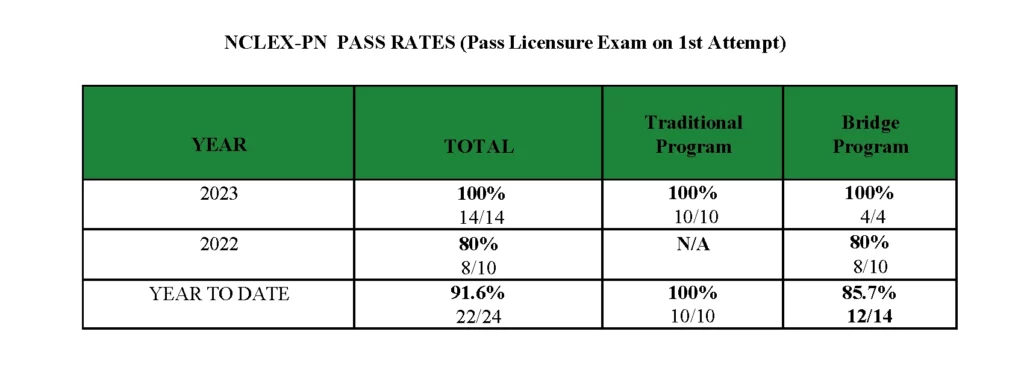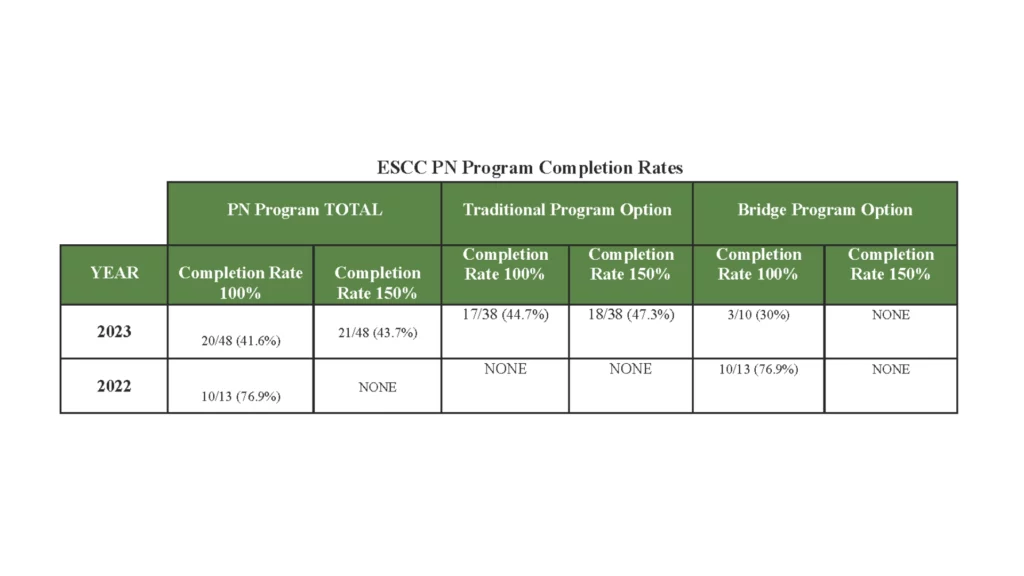ESCC Practical Nursing Program Outcomes


- Performance on Licensure Exam
Graduates as a composite of first-time writers, shall achieve no less than eighty percent (80%) pass rate on board selected national licensure exam as defined by the Alabama Board of Nursing. The program’s most recent annual licensure examination pass rate will be at least 80% for all first-time test-takers during the same 12-month period as defined by the Accreditation Commission for Education in Nursing (ACEN).
- Program Completion
At least 30% of students admitted will graduate on time for both PN program types.
At least 40% of students will graduate in 150% of the time of the stated program length beginning with the first required nursing course, as delineated below:
Paramedic/CMA/CCMA to PN Certificate– One semester
Traditional PN Certificate- Four semesters
- Job Placement
At least 90% of the graduates will report employment as a practical nurse within 12 months of program graduation.
- Graduate and Employer Surveys
Graduate and employer surveys are not mandated. Programs may continue to use the surveys as additional tools for assessing and evaluating program outcomes.
Concept-Based Curriculum
Practical Nursing End-of-Program
Student Learning Outcomes/Graduate Competencies
Human Flourishing
Promote the dignity, integrity, self-determination, and personal growth of diverse patients, their families, and oneself to provide individualized, culturally appropriate, relationship-centered nursing care (NLN, 2014).
Patient-Centered Care
Advocate for the patient and family in the provision of compassionate and coordinated care to support the health, safety, and well-being of patients and families (QSEN, 2012).
Nursing Judgment
Make judgments in practice, substantiated with evidence, that integrate nursing science in the provision of safe, quality care for diverse patients and their families in collaboration with the health care team (NLN, 2014).
Informatics
Incorporate information and technology within own scope of practice to support safe processes of care (QSEN, 2012).
Safety
Demonstrate the effective use of strategies to reduce risk of harm to self or others (QSEN, 2012).
Professional identity
Articulate a unique role as a member of the healthcare team, committed to evidence-based practice, caring, advocacy, and safe quality care, to provide optimal health care for diverse patients and their families (NLN, 2014).
Teamwork and Collaboration
Function competently within own scope of practice as a member of the health care team (QSEN, 2012).
Spirit of Inquiry
By collaborating with healthcare team members, utilize evidence, tradition, and patient preferences in predictable patient care situations to promote optimal health status (NLN, 2014).
Quality Improvement
Utilize various sources of information to review outcomes of care identifying potential areas for improvement of the quality and safety of care (QSEN, 2012).
Evidence-Based Practice
Implement evidence-based practice in the provision of individualized health care (QSEN, 2012).

